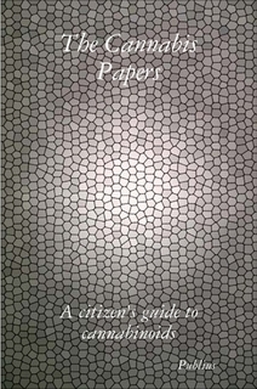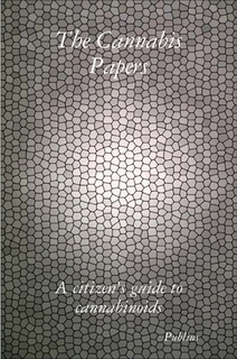 The Cannabis Papers by Publius (2011)
The Cannabis Papers by Publius (2011) The Cannabis Papers: A citizen’s guide to cannabinoids (2011)
By Publius
A World (Cup) of Cannabinoids: Fielders Edition
Today’s science roundup looks at ten articles on how the cannabinoid system (CS) modulates our health and homeostasis; the line-up links to 2014 CS PubMed articles: four directly on homeostasis, two on the circulatory system, two on the central nervous system, and one each on our digestive and respiratory systems.
I. CNS (Pediatric Brain Injury) and the CS
“Paediatric traumatic brain injury (TBI) is a leading cause of death and disability. Previous studies showed neuroprotection after TBI by (endo)cannabinoid mechanisms, suggesting involvement of cannabinoid receptors (CBR). … The results may provide explanation for the neuroprotective properties of cannabinoid ligands and future therapeutic strategies of TBI.”
Early increase of cannabinoid receptor density after experimental traumatic brain injury in the newborn piglet.
Donat CK, Fischer F, Walter B, Deuther-Conrad W, Brodhun M, Bauer R, Brust P.
Acta Neurobiol Exp (Wars). 2014;74(2):197-210.
PMID: 24993629 [PubMed - in process]
Related citations
II. Digestive System (Irritable Bowel Syndrome) and the CS
“The activation of the ATP ion-gated channels, voltage-gated sodium (Nav) and calcium (Cav) channels, as well as the activation of protease-activated receptors (PAR2), transient receptor potential vanilloide-1, serotonin, cannabinoids and cholecystokinin are involved in the genesis of visceral hypersensitivity in IBS.”
Main ion channels and receptors associated with visceral hypersensitivity in irritable bowel syndrome.
de Carvalho Rocha HA, Dantas BP, Rolim TL, Costa BA, de Medeiros AC.
Ann Gastroenterol. 2014;27(3):200-206. Review.
PMID: 24976114 [PubMed - as supplied by publisher] Free PMC Article
Related citations
III. Respiratory System (Paraquat and Acute Lung Injury) and the CS
“Paraquat [PQ], a widely used herbicide, is well known to exhibit oxidative stress and lung injury. … The results suggested that activating CB2 receptor exerted protective activity against PQ-induced ALI [Acute Lung Injury], and it potentially contributed to the suppression of the activation of MAPKs and NF- κ B pathways.”
CB2 Receptor Activation Ameliorates the Proinflammatory Activity in Acute Lung Injury Induced by Paraquat.
Liu Z, Wang Y, Zhao H, Zheng Q, Xiao L, Zhao M.
Biomed Res Int. 2014;2014:971750. doi: 10.1155/2014/971750. Epub 2014 May 22.
PMID: 24963491 [PubMed - in process] Free PMC Article
Related citations
IV. Homeostasis (Indole Quinuclidine Analogs) and the CS
“Therefore, indole quinuclidines are a novel structural class of compounds exhibiting high affinity and a range of intrinsic activity at cannabinoid type-1 and type-2 receptors.”
Characterization of the intrinsic activity for a novel class of cannabinoid receptor ligands: Indole quinuclidine analogs.
Franks LN, Ford BM, Madadi NR, Penthala NR, Crooks PA, Prather PL.
Eur J Pharmacol. 2014 Aug 15;737:140-8. doi: 10.1016/j.ejphar.2014.05.007. Epub 2014 May 20.
PMID: 24858620 [PubMed - in process]
Related citations
V. Circulatory System (Ischemic Heart Disease) and the CS
“Ischemic heart disease is associated with inflammation, interstitial fibrosis and ventricular dysfunction prior to the development of heart failure. … Therefore, the endocannabinoid-CB2 receptor axis plays a key role in cardioprotection during the initial phase of ischemic cardiomyopathy development.”
The endocannabinoid-CB2 receptor axis protects the ischemic heart at the early stage of cardiomyopathy.
Duerr GD, Heinemann JC, Suchan G, Kolobara E, Wenzel D, Geisen C, Matthey M, Passe-Tietjen K, Mahmud W, Ghanem A, Tiemann K, Alferink J, Burgdorf S, Buchalla R, Zimmer A, Lutz B, Welz A, Fleischmann BK, Dewald O.
Basic Res Cardiol. 2014 Jul;109(4):425. doi: 10.1007/s00395-014-0425-x. Epub 2014 Jul 1.
PMID: 24980781 [PubMed - in process]
Related citations
VI. Homeostasis, Endocannabinoid Deficiencies and the CS
“Subsequent research has confirmed that underlying endocannabinoid deficiencies indeed play a role in migraine, fibromyalgia, irritable bowel syndrome and a growing list of other medical conditions. Clinical experience is bearing this out. Further research and especially, clinical trials will further demonstrate the usefulness of medical cannabis. As legal barriers fall and scientific bias fades this will become more apparent.”
Clinical endocannabinoid deficiency (CECD) revisited: Can this concept explain the therapeutic benefits of cannabis in migraine, fibromyalgia, irritable bowel syndrome and other treatment-resistant conditions?
Smith SC, Wagner MS.
Neuro Endocrinol Lett. 2014 Jun 30;35(3):198-201. [Epub ahead of print]
PMID: 24977967 [PubMed - as supplied by publisher]
Related citations
VII. Homeostasis (Epilepsy, Neuronal Plasticity) and the CS
“Synaptic communication requires constant adjustments of pre- and postsynaptic efficacies. In addition to synaptic long-term plasticity, the presynaptic machinery underlies homeostatic regulations which prevent out of range transmitter release. In this mini-review we will discuss the relevance of selected presynaptic mechanisms to epilepsy including voltage- and ligand-gated ion channels as well as cannabinoid and adenosine receptor signaling.”
Presynaptic mechanisms of neuronal plasticity and their role in epilepsy.
Meier J, Semtner M, Winkelmann A, Wolfart J.
Front Cell Neurosci. 2014 Jun 17;8:164. doi: 10.3389/fncel.2014.00164. eCollection 2014. Review.
PMID: 24987332 [PubMed]
Related citations
VIII. Homeostasis (Turning Agonists into Antagonists) and the CS
“However, we discovered that bivalency has an influence on the effect at both cannabinoid receptors. Moreover, we found out that the spacer length and the attachment position altered the efficacy of the bivalent ligands at the receptors by turning agonists into antagonists and inverse agonists.”
Synthesis and biological evaluation of bivalent cannabinoid receptor ligands based on hCB2R selective benzimidazoles reveal unexpected intrinsic properties.
Nimczick M, Pemp D, Darras FH, Chen X, Heilmann J, Decker M.
Bioorg Med Chem. 2014 Jun 13. pii: S0968-0896(14)00454-4. doi: 10.1016/j.bmc.2014.06.008. [Epub ahead of print]
PMID: 24984935 [PubMed - as supplied by publisher]
Related citations
IX. Circulatory System (Blood Vessels-Heart) and the CS
“2-Arachidonoylglycerol [2-AG] plays an important role in the regulation of the circulatory system via direct and/or indirect, through their metabolites, effects on blood vessels and/or heart. Accumulating evidence reveals that 2-AG is involved in the pathogenesis of various shocks and atherosclerosis.”
Role of endocannabinoid 2-arachidonoylglycerol in the physiology and pathophysiology of the cardiovascular system.
Karabowicz P, Grzęda E, Baranowska-Kuczko M, Malinowska B.
Postepy Hig Med Dosw (Online). 2014 Jun 12;68(0):814-27.
PMID: 24934539 [PubMed - in process]
Related citations
X. CNS (Brain Mitochondria) and the CS
“Our results show that the use of appropriate controls and quantifications allows detecting mtCB1 receptor with CB1 receptor antibodies, and that, if mitochondrial fractions are enriched and purified, CB1 receptor agonists reliably decrease respiration in brain mitochondria.”
Cannabinoid control of brain bioenergetics: Exploring the subcellular localization of the CB1 receptor.
Hebert-Chatelain E, Reguero L, Puente N, Lutz B, Chaouloff F, Rossignol R, Piazza PV, Benard G, Grandes P, Marsicano G.
Mol Metab. 2014 Apr 2;3(4):495-504. doi: 10.1016/j.molmet.2014.03.007. eCollection 2014 Jul.
PMID: 24944910 [PubMed] Free PMC Article
Related citations
See also: Alzheimer’s, Cancer and Homeostatic Cannabinoid Science
Bonus Video: Homeostasis
Posted by Bryan W. Brickner








 RSS Feed
RSS Feed
